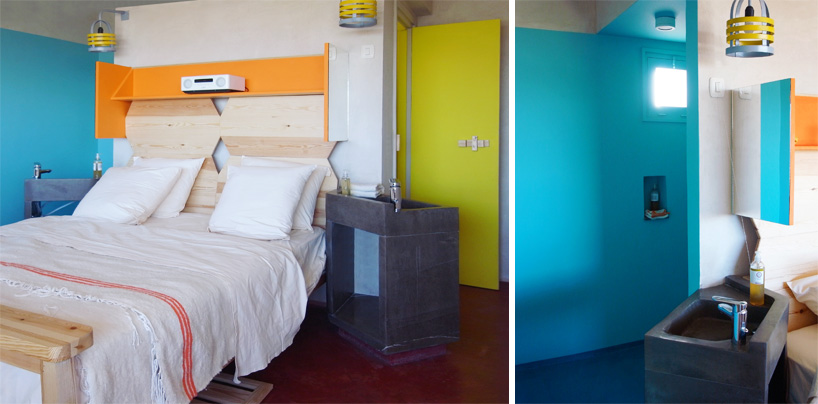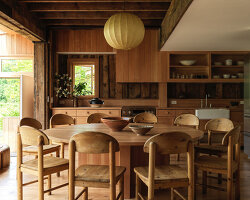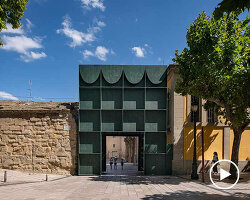wrap around windows in pilotis hotel room nr.4 image courtesy Dar HI
a few days before its official opening, designboom visited the new Dar HI, an exclusive eco-retreat in nefta, in southern tunisia. the Dar HI is a search for self-sufficiency and local development. it is located at the base of a palm-tree oasis at the edge of the sahara. for the project, parisian designer matali crasset has envisioned a compound comprised of 17 units with non-decorative furniture and accented with brightly-colored walls.
 the view over nefta from the panorama bow window of pilotis hotel room nr.4 image © designboom
the view over nefta from the panorama bow window of pilotis hotel room nr.4 image © designboom
the Dar HI is crasset’s first architectural project. the overall goal of the design was to give a strong proposition, while staying in harmony with the site’s natural and local life. the eco-retreat and spa features elevated views of nefta, a tiny village at the foot of a palm-tree oasis in southern tunisia. the local date grove is a gem within a fragile environment, that has to be preserved and renovated. the renovation started with a great development financed by the albert de monaco foundation. Dar HI is committed in the same preservation and development of the oasis. a research laboratory will be in Dar HI to find new ways and techniques to use the palm tree and the dates.
 … the unique panorama of nefta image © designboom
… the unique panorama of nefta image © designboom
each room features a generous bow window which offers a panoramic view of the palm grove and desert beyond. the window is lined with cushioned seating and an elevated lounge space executed in concrete, outfitted with brightly upholstered orange and blue daybeds. cubby holes within the concrete bases provide storage space for shoes and blankets.
 image © designboom
image © designboom
 wash basins function as bed side tables, with the shower hidden behind the bed’s headboard / wall. also hidden in a separate yellow room you’ll find a washroom. image © designboom
wash basins function as bed side tables, with the shower hidden behind the bed’s headboard / wall. also hidden in a separate yellow room you’ll find a washroom. image © designboom
wash basins are housed outside the bathroom on either sides of the bed, serving as individual bed-side tables / vanity sinks. the shower is hidden behind the bed’s headboard / wall. also hidden in a separate yellow room you’ll find a washroom. this set-up allows for a spacious room, where no excess divisions interrupt the clean lines of design.
 image © designboom
image © designboom
 interior of pilotis hotel room nr. 5 image courtesy Dar HI
interior of pilotis hotel room nr. 5 image courtesy Dar HI
 a steamy geothermal hammam image © designboom
a steamy geothermal hammam image © designboom
all the hot water in the rooms and hammam are generated through geothermal techniques, taking advantage of the natural energy supply of the area, while cutting down on operation expenses.
 images © designboom
images © designboom
sinks are done in foussana marble, while the walls of the spa area are covered with faience designed by matali, that use a combination of colors from turquoise blue, light blue, acid green and orange.
 images © designboom
images © designboom
 image © designboom
image © designboom
the communal space is accented with artichoke yellow on the columns and the backs of cut-out shelves. small pendant lamps are suspended at varying heights throughout the space, their shapes serving as a motif on the fireplace hearth.
 image © designboom
image © designboom
 the babouche rack (where guests can exchange their shoes for handmade berber slippers) image © designboom
the babouche rack (where guests can exchange their shoes for handmade berber slippers) image © designboom
a discreet door leads you to this guest house. the entrance, a corridor, has a ramp and is the last stop where you leave your usual behavior and codes at the door. you take off your shoes and slip into a pair of babouches (tunisian slippers). you are at home.
 image © designboom
image © designboom
the hotelier partners, patrick elouarghi and philippe chapelet wanted the Dar HI to be a search for self-sufficiency and local tourism development, using the resources available at hand rather than importing materials from abroad. for patrick elouarghi, the choice of tunisia is firstly an expression of familial commitment: ‘my father is tunisian and I have long had the wish to develop a project in tunisia.’ creating a place in the desert is not easy, and the Dar Hi responds to the very contemporary need to have a place of withdrawal from the fast pace of the world.
 images © designboom
images © designboom
nefta is an important religious village, a platform of sufism that gives a poetic and mystical dimension to it. ‘the dar hi is not a hotel or a classic spa, but a completely different place in which you can live an experience of withdrawal into oneself. where everyone can enjoy a ‘spa for the mind’, located in the open desert, just a few hours from paris,‘ says philippe chapelet.
 elevated thermal pool with hot springs from the desert with views onto date groves and palm trees galore image © designboom
elevated thermal pool with hot springs from the desert with views onto date groves and palm trees galore image © designboom
being in the desert, the question of water supply is therefore decisive. the water arriving in nefta comes from a hot spring source of the desert and supplies the Dar HI with water for the hammam and outdoor pool. this water is also present in small ditches around the pill houses and allows the irrigation of the oasis.
 the thermal pool and the ‘pilotis’ image © designboom
the thermal pool and the ‘pilotis’ image © designboom
the owners have based their project on the modern day values of our society and have invested in the following fields: contemporary art, design, music, ecology, organic and sustainable development, technology … Hi life is the development of this new type of tourism and will be developed further with other franchised based small projects.
 thermal pool with hot springs from the desert image © designboom
thermal pool with hot springs from the desert image © designboom
philippe chapelet and patric elouargy have been working together for twenty years. after opening the first world food concept store in paris,’l’epicerie du monde’, they decided to move to the countryside and refurbished the chateau de la tremblaye in the loire valley, which became a ‘chateaux & hôtels de france’ member within its first year of opening. in 2001, they set a new challenge for themselves: to invent a hotel with new standards, transcending the conventions and clichés of luxury hotels. they came up with HI hotel in nice, france, also designed by matali crasset.
 still under construction image © designboom
still under construction image © designboom
the ‘troglodyte styled suites’ appear as if they are burrowed out of the rocks. their forms are derived from the cave dwellings of matmâta, a village not far from nefta – about an hour away by car. during summer months (from june to august), the interior is comfortably fresh despite the hot, dry climate of the desert. these areas are built from small bricks from nefta and are completely independent with their own private terraces, but are also linked together by a circular area from one to the other. collective life is articulated around a small square with a water cascade and a bread oven. these rooms can be rented for a stay with friends or family. they are still under construction and will be ready at the end of 2010.
 still under construction image © designboom
still under construction image © designboom
other areas are called ‘dunes’, which are located at ‘sand level’. they appear as big open spaces, as if the wind would have sculpted them out. the reference was the bivouac that allows you to modulate your comfort as you wish – the experience of living within the dunes and creating your own nest to feel closer to the desert. each ‘dune’ is different: one has a loggia with natural light and an indoor garden, another has an external terrace and a large window with a view of nefta. a third offers a view of the date grove with an independent room and an alcove wooden terrace.
 rendering by matali crasset
rendering by matali crasset
fifteen minutes from the tozeur airport, nefta is entrance to the southern tunisian desert, between chott el-jerid and the sand dunes. the site is fabulous. if you are a curious traveler looking for a unique experience, it is also possible to spend a few days of your stay within the date grove in a palm tree berber tent.
 ancient berber village in mides image © designboom
ancient berber village in mides image © designboom
 tamerza canyon and chott el djerid images © designboom
tamerza canyon and chott el djerid images © designboom
chott el djerid – chotts are depressions that fill with salt once moisture from the sahara’s winter rains evaporates in the spring and summer. located in southern tunisia, the remote salt pan is a series of oases that is worth the difficult trip. although it is possible to reach the chott el gharsa by bus, the area is largely devoid of public transport. it is best to organize a day trip with tour companies.
 we went to the desert dunes image © designboom
we went to the desert dunes image © designboom
 moving dunes, star wars scenery and ‘camels cross here’ sign in sahara desert images © designboom
moving dunes, star wars scenery and ‘camels cross here’ sign in sahara desert images © designboom
on the southern border of chott el gharsa near the algerian border lies the filming locations for various scenes of the star wars films. the elaborate sets were constructed in this area where the only access is via a sand road through the middle of the sahara. this road was built for the filming of ‘the english patient’ and was extended for the filming of the star wars prequels. for some unexplained reason, most of the sets in this area were left intact after filming was completed.
 star wars tatooine planet image © designboom
star wars tatooine planet image © designboom
the tatooine planet from the legendary saga by george lucas still exists – the troglodyte village is a scenery from ‘star wars’ films shot in the sahara desert.
click here to read part one of our feature on the Dar HI hotel.





















